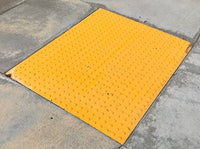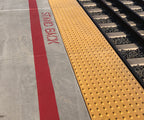
Surface Applied Truncated Domes for Installation on Concrete
Retrofit/Surface Applied Truncated Domes for Dry Concrete Application from ADA Sign Depot
While the Americans With Disabilities Act was passed in 1992, it was not until much later, after exhaustive studies, that truncated domes were legally required for many areas on private property, including curb cut outs, parking lot environments, wheelchair ramps, entrances, and paths of travel.
This has led to many businesses needing to install truncated domes on concrete that was already in place. Surface applied truncated domes (also called retro-fit or surface mounted) allow property owners and managers to install ADA required truncated domes pads without having to demolish, remove, and re-pour fresh concrete. Recent advances in bonding technology have made possible self-adhesive truncated domes pads that do not need anchoring hardware and can be easily applied without special tools. These peel and stick truncated dome bump pads not only adhere to concrete, but also bond to asphalt and wood surfaces.
While yellow is the most commonly ordered of our surface applied retro-fit truncated domes, we offer many color choices, because ADA rules require contrast between paving tile truncated domes and the surrounding surface on which they are applied. Most orders ship in 1-3 business days.
Because of their size, weight, and industrial adhesive/moisture sealants, Truncated Domes can only be shipped by Ground Transport to a Business Address. Expedited shipping is not available.
Have questions? Need a quote on a larger project? Contact us
Kent M., Contractor
"Quick and easy with a great selection all truncated domes!"
Why Have Truncated Domes Become So Much More Visible Recently?
A Brief Timeline for Truncated Domes1991: Detectable Warning Surfaces were first required with the release of the Americans with Disabilities Act Accessibility Guidelines. Detectable Warnings were required on hazardous vehicle ways, transit platform edges, and curb ramps.
1994-2001: A suspension was placed on the requirements with the exception of transit platforms so that research could be conducted on the detectability of the varying tactile surfaces such as grooves, striations, and exposed aggregate. When completed, the research determined that those surfaces were in fact not detectable due to the similarities to normal surface defects found on sidewalks and roadways.
July 26th, 2001: The suspension regarding tactile warnings was allowed to expire and truncated dome detectable warnings specified in the ADAAG were again required.
2001-Present: Truncated Domes are an Americans with Disabilities Act (ADA) requirement in the current Americans with Disabilities Act Accessibility Guidelines (ADAAG) for the use of detecting the boundary between the sidewalk and the street. Truncated domes are the only detectable warnings allowed by ADAAG. Grooves, exposed aggregate, and other designs intended for use as detectable warning are too similar to pavement textures, cracks and joints and are not considered equivalent facilitation. Truncated domes are a unique design and have proven to be the most detectable surface.
Shop all Truncated Domes



























